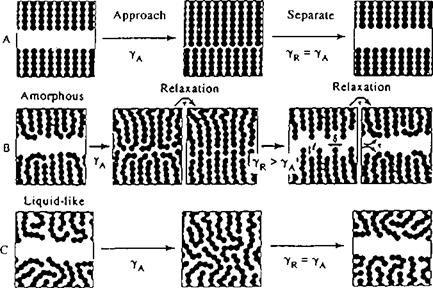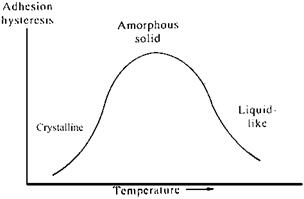Why does surface roughness affect adhesion? More particularly, why does increasing interfacial roughness often increase adhesion? In a simple way, we can rationalize this in terms of Eq. (6), at the same time summarizing the points made in the previous sections.
|
|
|
Let us examine each term in turn, considering how it might contribute to the hypothetical fracture energy G of the adhesive joint:
G = G0 + f (6)
The surface energy term G0 is of the form ‘‘surface excess energy’’ per unit area of surface (cf. Eq. (1)), so may be expressed as
![]() _ AG 0 = ~A
_ AG 0 = ~A
It is readily appreciated that surface treatments may increase AG by introducing more chemically active groups into the substrate surface. This is a central idea in the adsorption theory of adhesion. Surface treatments that are regarded as primarily roughening a surface will usually bring about cognate chemical change. Over and above this, AG will also be increased as a result of roughening the surface per se. An atom near an asperity peak or fine fractal feature will clearly have a much greater ‘‘atomic’’ surface energy than a chemically similar atom in a plane crystal surface.
Turning to the area A in Eq. (17), it is important to remember that A refers to the formal area, the macroscopic area of the interface. For the rough surface the ‘‘true’’ area will be greater. As we move from macroroughness towards roughness on a nanoscale and molecular scale, we move seamlessly from the historic realm of the mechanical theory into the realm of the diffusion theory, and at the same time the effective increase in A can become enormous. Consequently G0 may be raised to a very high value. Indeed, as many engineering surfaces are fractal in nature [61], we can only retain the concept of‘‘area’’ at all, if we accept that it can be considered as indefinitely large. The practical adhesion does not become infinite because the joint with a strong interfacial region will fail (cohesively) in some other region where G0 is smaller.
It must further be remembered that G0 will often be coupled to the ‘‘other’’ loss terms f (cf. Eq. (7)). This means that even a modest absolute increase in G0 may lead to a much larger increase in fracture energy G.
Returning to Eq. (6), let us now consider explicitly the other energy absorbing processes ф which occur during fracture. These often make the dominant contribution to G. As we have seen, where interdigitation of polymer chains is involved, these losses may include energy involved in chain pull-out or scission. It is notable that the highest fracture energy occurs where the interdigitation is sufficiently extensive to initiate crazing or other plastic dissipation processes.
For many adhesive bonds, there is a very large difference in elastic modulus between the two phases joined. This has the effect of concentrating applied stresses at the interface, leading to smooth crack propagation close to the interface, often giving a low fracture energy. A rough surface, especially a microfibrous or microporous one, can be seen as causing local stress concentrations which interfere with this smooth crack propagation. This discontinuity can lead to the deformation of larger volumes of material leading to increased energy loss [85]. Although this deformation is often plastic, the work of Gent and Lin [71] has clearly shown that loss of elastic strain energy can also be important.
A high modulus gradient at the interface is also avoided in materials that are joined as a result of the interdiffusion of materials to form a fractal surface [57]. The effect is to produce an interfacial composite region. This strengthens the interface and leads to a more gradual change in modulus and avoids the sharp concentrations of stress which would occur at a smooth interface.
The weakness of an interface may also be protected by features of macroscopic roughness deflecting applied stresses into a tougher bulk phase. Examples of this mechanism are provided by the influxes between incompatible crystalline polymers [67-70] and the copper-silica bond [66], both described above.
Let us finally return to Eq. (6) and consider the implications of rough fracture surfaces. It is significant that the fracture surfaces produced when strong adhesive bonds are broken are often extremely rough. (This, of course, holds for strong bonds irrespective of the roughness of the substrate surface.) Equation (6) gives the fracture energy in terms of the different energies which contribute to it. To be specific, suppose
the failure mode is cohesive. Should the surface energy term be WC, given by Eq. (5)? This would not take into account the very rough surfaces produced in the fracture. The surface energy term needs to be increased by two factors, the first, r, taking into account the larger surface area, the second, s, allowing for the increased ‘‘atomic’’ surface energy on the rough surface:
W£= 2rsy = WC + (2rs — 2)y (18)
If the roughness of the fracture surface is large this may be written as
WC = 2rsy = WC + 2rsy (19)
and Eq. (6) is now
G = G0 + 2rsy + f (20)
The term r might be the roughness factor, but as argued above, it should often be a factor involving the fractal dimension of the fracture surfaces, which, as Table 1 shows, may extremely large. Substituting from Eq. (14) then gives
G = G0 + 2sya1-D/1 + f (21)
Mecholsky [86] has proposed an equation of this sort to represent the brittle fracture of ceramics: it would be of interest to investigate its applicability to the fracture of adhesive bonds.
 21 июня, 2015
21 июня, 2015  Malyar
Malyar 

 Опубликовано в рубрике
Опубликовано в рубрике 